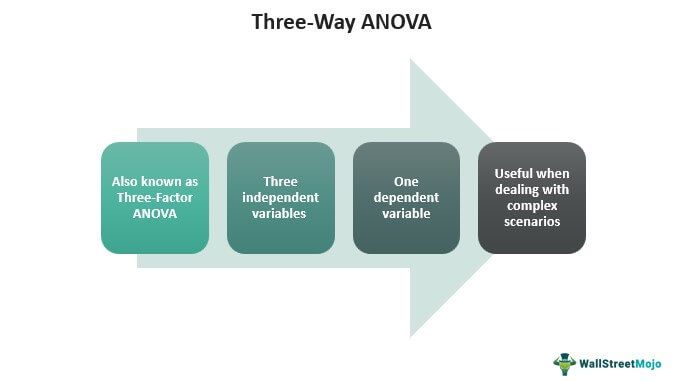Table Of Contents
Three-Way ANOVA Definition
Three-way ANOVA is a type of ANOVA test containing three independent variables and one dependent variable. The independent variables are categorical, whereas the dependent variable is continuous. It is primarily used to understand the influence of more than one variable on the outcome of a given scenario.

Three-way anova is also called three-factor ANOVA, where the ANOVA stands for analysis of variance. It tells an analyst whether the variance occurred by chance or by the influence and interaction of the factors (variables) involved in the scenario. It is often compared with one-way and two-way ANOVA tests, and their primary difference lies in the number of independent variables used.
Key Takeaways
- The three way ANOVA test has three independent variables and one dependent variable.
- The three way ANOVA test has three independent variables and one dependent variable.
- Some of its assumptions include the continuous type of dependent variable, categorical independent variables, independence of observations, absence of significant outliers, etc.
- It can be seen in complex and challenging scenarios where the statisticians deal with three variables and tend to study their influence on the outcome or dependent variable.
3-Way ANOVA Explained
The three-way ANOVA focus on interaction sighted among three independent variables and its combined effect on the outcome variable, that is, the continuous dependent variable. It is applied when three variables interact with each other, and in an experimental setup, the different combinations of independent factors are applied to the same number of subjects. Independent variables are not dependent on any other factor for their value and variance. At the same time, dependent variables are the ones that analyst typically want to seek answers to and is studied by regulating the values of independent variables.
It is primarily used to solve complex scenarios where three variable influences the outcome. There are also certain assumptions for checking the aptness of the test's application. For example, firstly, the dependent or outcome variable should be continuous, independent variables should be categorical, independent observations in the group and between the groups, disfavouring the presence of outliers, normally distributed population, and homogeneity of variances.
The formulas used for the three way ANOVA test is similar to the ones used in the two-way ANOVA test. In other words, it is an extension of the two-way ANOVA method. Also, there are three-way anova formulas in Excel.
Examples
Let us look into some of the three-way ANOVA examples:
- A researcher can use 3-way ANOVA to analyze the spending habit. The independent factors are gender, age, and income. These independent factors are categorical and can be segregated into different groups or levels. Gender can be male or female, age can fall into the groups or levels like youth, adults, or seniors, and income levels can be low, middle, and high income. The outcome of the test is explained by the amount spent; hence amount spent is the dependent variable. In this case, the dependent variable depends on the independent factors such as gender, age, and income of the participants.
- Local geology often determines the chemical nature of the lime used to create lime mortars. In addition, different forms of lime are produced depending on certain events, for instance, the slaking and the amount of water utilized in the process. As a result, the composition and kind of lime utilized can impact how lime mortar behaves. Therefore, to evaluate the qualities of air lime mortars for their usage in cultural heritage conservation projects, a 3-way ANOVA study was conducted to ascertain the composition, type, temporal evolution, and interactions of these three factors.
- Factors influencing the students preparing for a test can be divided into three: the preparation technique followed, the number of chapters or concepts the student covers, and the student's IQ, whether superior or average. Each variable is independent. But the outcome is the student's score on the test, which is a dependent variable based on these three variables.
How To Interpret Three-Way Anova?
The three-way ANOVA interpretation is made by analyzing the change in all the three independent variables and how it influences the outcome. The researcher can regulate each independent variable to understand its influence on the fourth continuous dependent variable. Importantly, the combined relationship between all three variables is analyzed, and the variance in the outcome is derived. It points to the importance of interaction between three independent variables and its effect on the dependent variable. The effect of the independent variable changes in line with the levels of other independent variables.

